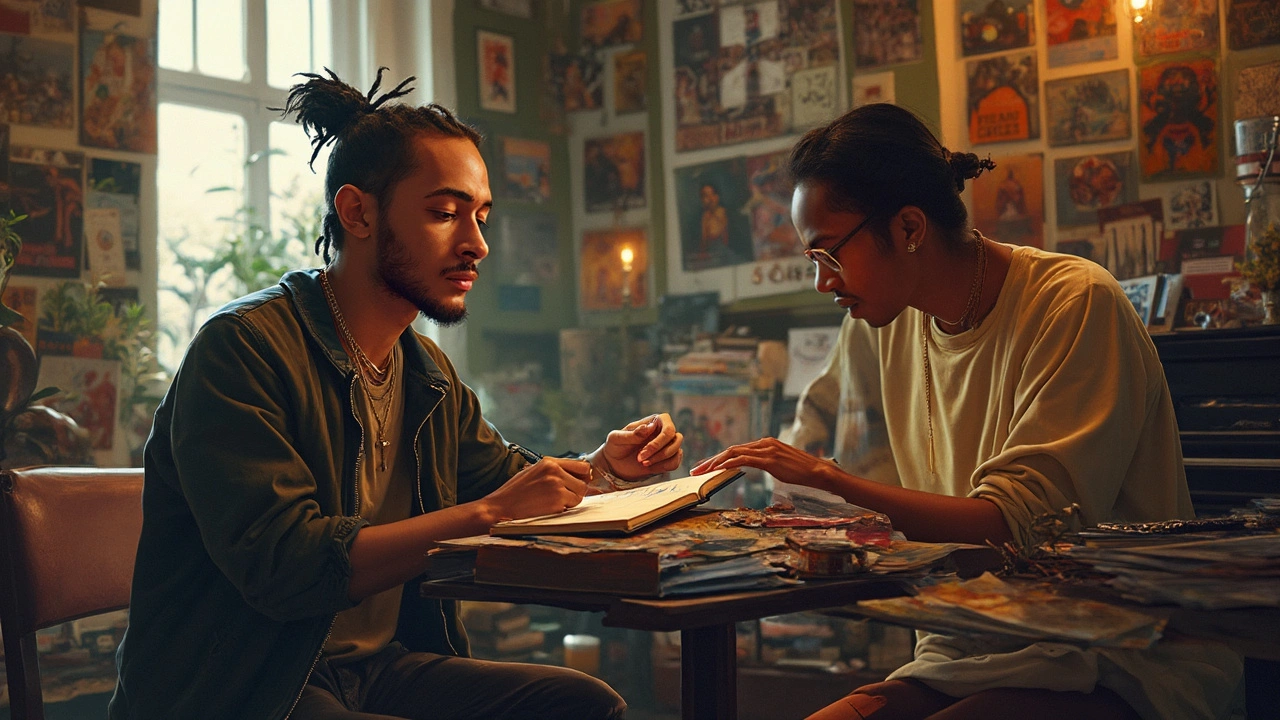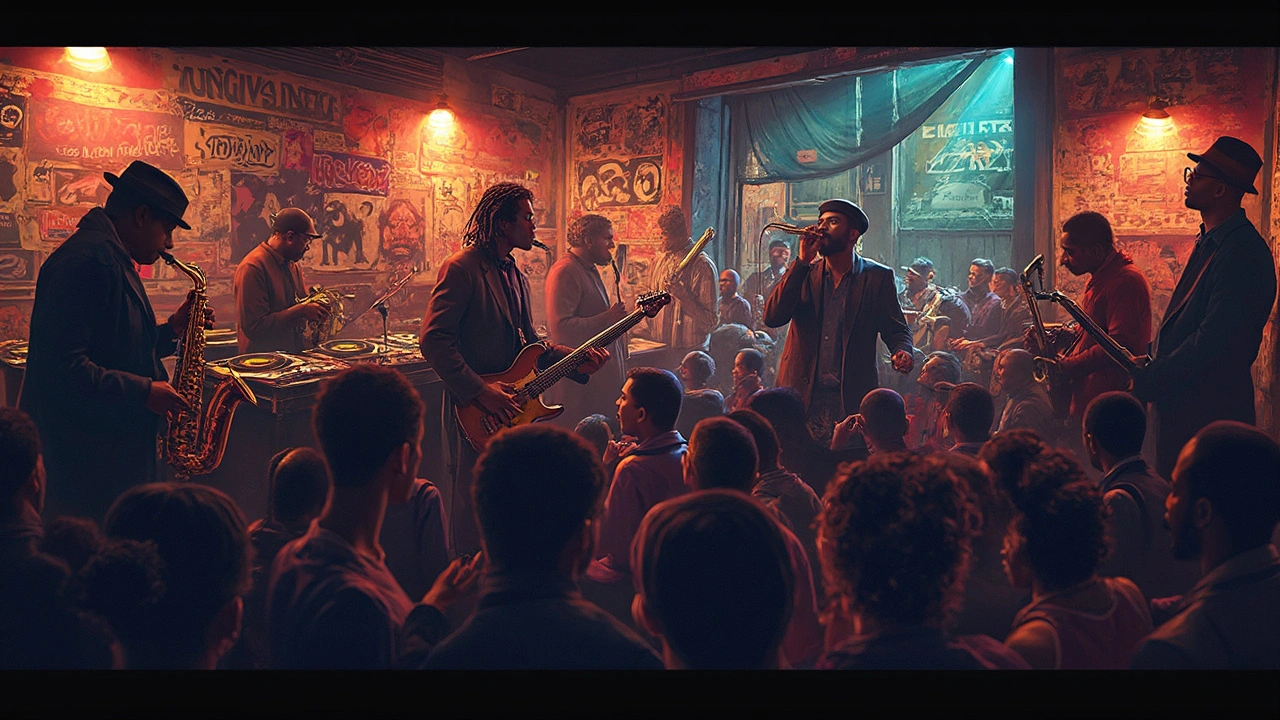What do you get when you mix the bounce of hip hop beats with the improvisational magic of jazz? A music genre that refuses to sit still. Hip hop and jazz haven't just crossed paths; they've blended into something new that keeps pushing boundaries. You're here for the inside scoop: What exactly does a fusion of hip hop and jazz sound like? How did it start, who's leading the charge, and how can you spot these genre-bending moments in your playlist? If you want to connect with the roots of this mashup and spot the best examples, you’re in the right place.
Here’s the quick lowdown you need:
- Hip hop and jazz fuse through sampling, live instrumentation, and improvisation—creating "jazz rap."
- This blend dates back to the late 1980s, kicked off by artists like A Tribe Called Quest and Gang Starr.
- Key tracks and albums set the gold standard for this style—think Guru's "Jazzmatazz" and Kendrick Lamar’s "To Pimp a Butterfly."
- Sampling jazz classics and adding rap flows isn’t just a throwback move—new artists keep evolving the fusion in 2025.
- If you want to try this style yourself, you’ll need clever sample choices, a sense of groove, and a willingness to break "genre rules."
How Hip Hop and Jazz Started to Blend
Back in the late ‘80s, hip hop was famous for its punchy drum machines and street poetry. Jazz, meanwhile, had its fanbase hooked on improvisation, swaying horns, and lush instrumentals. But the two worlds started crossing over once producers discovered how good jazz records sounded when looped under rap verses.
Listen to A Tribe Called Quest's "Jazz (We've Got)" from 1991. It wasn’t just a shoutout—these guys were actually looping jazz basslines and drumming breaks, proving jazz could form the backbone of hip hop. Around the same time, Gang Starr’s DJ Premier used old jazz records to build gritty yet soulful beats. And in 1993, Guru’s “Jazzmatazz, Vol. 1" went a step further, bringing live jazz musicians and rappers into the same studio.
If you dig into the history, you’ll spot a pattern: when hip hop acts ran with jazz influences, it opened doors. The beats got deeper, the raps got smoother, and fans paid more attention to musicianship. Even on this side of the world in Perth, you’ll spot buskers melding jazzy sax with rap flows during street festivals.
Key Tracks and Albums That Define Hip Hop Jazz Fusion
If you’re hunting for a crash course, you can’t skip these standouts:
- Guru – “Jazzmatazz, Vol. 1” (1993): This album is ground zero for jazz-rap collabs, with legends like Donald Byrd playing trumpet alongside smooth rap beats.
- A Tribe Called Quest – “The Low End Theory” (1991): It’s packed with double bass lines and tracks like "Excursions" that fuse jazz structure and hip hop storytelling.
- Digable Planets – “Rebirth of Slick (Cool Like Dat)” (1992): Instantly recognizable for its jazzy upright bass and breezy rap style.
- Kendrick Lamar – “To Pimp a Butterfly” (2015): This modern classic pushes boundaries with spoken word, live band improvisation, and production by jazz musicians like Kamasi Washington.
- Robert Glasper Experiment – “Black Radio” (2012): Glasper, a jazz pianist, teams up with rappers and R&B singers to deliver true crossover tracks.
These albums aren’t just worth a listen—they pretty much set the bar for what hip hop and jazz can do together. Take Kendrick’s work; he invites musicians who can play off the cuff, giving the record an energy you won’t find in programmed beats alone.
Techniques Behind the Fusion: Sampling, Improvisation, and Live Instruments
At the center of this blend is a toolkit that producers and musicians reach for again and again. First up, sampling. This means taking snippets from old jazz tracks—think funky piano melodies, upright bass loops, or legendary Blue Note drum breaks—and chopping them up for a brand-new beat. It’s a throwback and a creative leap in one move.
But sampling’s just the start. More recent artists don’t stop at lifting old recordings. They invite jazz musicians into the studio for fresh takes. So you might find a sax player adding fills, or a drummer riffing in real time while a rapper freestyles. The key is improvisation. Jazz DNA is all about riffing on the spot, which gives hip hop a looser, more unpredictable vibe.
Another huge factor: live instruments. On Kendrick Lamar’s "To Pimp a Butterfly," the backbone is built from electric bass, trumpet, piano, and drums—all played by top jazz cats. This combo still feels modern thanks to the hip hop production style: crisp snares, booming kicks, and sharp arrangements. In the last year, Aussie acts like Milan Ring or Perth collectives like Grievous Bodily Calm have started using these tricks, too—bridging club scenes and jazz nights.
If you’re thinking of dabbling, here are quick tips:
- Dig deep for samples, not just the overused classics.
- Don’t over-quantize drums. Jazz is about swing, not robotic perfection.
- Add unpredictable chord changes or solos that break the typical 16-bar loop.
- Don’t be shy with brass and woodwind. They cut through a mix like nothing else.

Future of Jazz-Hip Hop Fusion: Artists, Pitfalls, and What’s Next
The stage keeps evolving. Lately, jazz-rap has gone global—London’s Ezra Collective, US rapper Noname, and acts in Australia keep the movement alive. Big record labels now look for crossover appeal, so you hear more live jazz players on hip hop records.
But it isn’t smooth sailing for everyone. A common mistake is slapping a jazzy loop under a rap and calling it done. Authentic fusion takes more than that. It’s about giving artists space to experiment—and having respect for both traditions. For example, forced or lazy samples can make a track sound cheap. Instead, working with musicians, or using real instruments, yields a richer, more lasting sound.
Producers aiming for authenticity often take time to learn jazz basics: seventh chords, scales, and swing rhythms. Rappers study the way jazz greats like Miles Davis "talked" through their instruments, translating it to new flows or delivery. The best fusion tracks are the ones where you can’t tell which genre is in charge—the music just works.
In 2025, the formula’s far from stale. Thanks to social media, bedroom producers trade jazz breaks and hip hop acapellas in real time. Genre blending isn’t just a trick—it’s a philosophy that says "whatever feels right, goes." Jazz-rap festivals are popping up in Melbourne, London, and LA, proving this isn’t a niche, but a worldwide sound movement. Expect the line between genres to keep blurring—and for unlikely collabs to make headlines.
Jazz-Hip Hop at a Glance: Top Examples, Checklist, and Key Players
- Want a playlist starter? Search these: “Scenario” by A Tribe Called Quest, “Loungin’” by Guru, “Black Gold” by Esperanza Spalding & Q-Tip, “Might Be” by Anderson .Paak.
- Checklist for spotting great fusion:
- Samples with clear jazz roots (piano, horns, upright bass)
- Grooves that swing, not just snap to grid
- Room for instrumental solos
- Lyrical nods to jazz culture or history
- Current artists killing it: Kendrick Lamar, Robert Glasper, Kamasi Washington, Tom Misch, Alfa Mist, Jordan Rakei, and Perth’s own local bands mentioned earlier.
Want to go deeper? Listen out for live-podcast performances or local jam nights. They’re hotspots for jazz and hip hop heads to pull off spontaneous collabs.
| Technique/Element | Jazz Influence | Hip Hop Impact | Modern Example |
|---|---|---|---|
| Sampling | Old piano/ horn loops | Build beat backbone | "Can I Kick It?" - A Tribe Called Quest |
| Live Instruments | Sax, trumpet, bass | Organic, unpredictable feel | "King Kunta" - Kendrick Lamar |
| Improvisation | Solos, variation | Loose vocal flows | "No Problem" - Chance the Rapper |
| Lyrics | Jazz shoutouts, themes | Urban storytelling | "Music That My Mind” - NxWorries |
- If you’re a producer, start small—add a single jazz lick to your track and let live players take it from there.
- For rappers, try flowing to classic jazz loops to stretch your timing.
- Music fans? Follow radio shows like Gilles Peterson (BBC) or local Perth jazz-hip hop collectives for discoveries.
Mini-FAQ: Jazz-Hip Hop Fusion Questions Answered
- Is jazz-rap the same as lo-fi hip hop?
No. While lo-fi hip hop uses some jazz samples, true jazz-hip hop fusion involves more improvisation and live musicians, not just sleepy beats with a jazzy feel. - What’s the best way to learn jazz-rap production?
Start by studying both genres: dig into classic jazz records, and learn drum programming in hip hop. Try reproducing beats from Guru, A Tribe Called Quest, or Robert Glasper. - Are live jazz-hip hop shows worth it?
Absolutely. The energy is raw, unpredictable, and you’ll hear songs evolve on stage. In cities like Perth, hybrid gigs are becoming more common. - Can you make jazz-rap with digital-only tools?
Yes, but using virtual instruments and collaborating with live players online adds authenticity to your sound.
- Next steps for music creators: Link up with local jazz musicians or look for sample packs with real jazz elements. Collaborate, experiment, and keep one foot in each world.
- For music fans: Build a playlist of classic and trending jazz-rap tracks. Hit up local venues hosting fusion gigs—there’s usually something fresh in Perth’s music scene.
- For students/researchers: Study landmark albums and trace how producers use jazz harmony and rhythm to reshape hip hop. This blend keeps growing, so stay curious.

